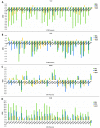Breeding Value of Primary Synthetic Wheat Genotypes for Grain Yield
- PMID: 27656893
- PMCID: PMC5033409
- DOI: 10.1371/journal.pone.0162860
Breeding Value of Primary Synthetic Wheat Genotypes for Grain Yield
Abstract
To introduce new genetic diversity into the bread wheat gene pool from its progenitor, Aegilops tauschii (Coss.) Schmalh, 33 primary synthetic hexaploid wheat genotypes (SYN) were crossed to 20 spring bread wheat (BW) cultivars at the International Wheat and Maize Improvement Center. Modified single seed descent was used to develop 97 populations with 50 individuals per population using first back-cross, biparental, and three-way crosses. Individuals from each cross were selected for short stature, early heading, flowering and maturity, minimal lodging, and free threshing. Yield trials were conducted under irrigated, drought, and heat-stress conditions from 2011 to 2014 in Ciudad Obregon, Mexico. Genomic estimated breeding values (GEBVs) of parents and synthetic derived lines (SDLs) were estimated using a genomic best linear unbiased prediction (GBLUP) model with markers in each trial. In each environment, there were SDLs that had higher GEBVs than their recurrent BW parent for yield. The GEBVs of BW parents for yield ranged from -0.32 in heat to 1.40 in irrigated trials. The range of the SYN parent GEBVs for yield was from -2.69 in the irrigated to 0.26 in the heat trials and were mostly negative across environments. The contribution of the SYN parents to improved grain yield of the SDLs was highest under heat stress, with an average GEBV for the top 10% of the SDLs of 0.55 while the weighted average GEBV of their corresponding recurrent BW parents was 0.26. Using the pedigree-based model, the accuracy of genomic prediction for yield was 0.42, 0.43, and 0.49 in the drought, heat and irrigated trials, respectively, while for the marker-based model these values were 0.43, 0.44, and 0.55. The SYN parents introduced novel diversity into the wheat gene pool. Higher GEBVs of progenies were due to introgression and retention of some positive alleles from SYN parents.
Conflict of interest statement
The authors have declared that no competing interests exist.
Figures





Similar articles
-
Response to Early Generation Genomic Selection for Yield in Wheat.Front Plant Sci. 2022 Jan 11;12:718611. doi: 10.3389/fpls.2021.718611. eCollection 2021. Front Plant Sci. 2022. PMID: 35087542 Free PMC article.
-
The Haplotype-Based Analysis of Aegilops tauschii Introgression Into Hard Red Winter Wheat and Its Impact on Productivity Traits.Front Plant Sci. 2021 Aug 17;12:716955. doi: 10.3389/fpls.2021.716955. eCollection 2021. Front Plant Sci. 2021. PMID: 34484280 Free PMC article.
-
Hyperspectral Reflectance-Derived Relationship Matrices for Genomic Prediction of Grain Yield in Wheat.G3 (Bethesda). 2019 Apr 9;9(4):1231-1247. doi: 10.1534/g3.118.200856. G3 (Bethesda). 2019. PMID: 30796086 Free PMC article.
-
Marker-assisted selection to improve drought adaptation in maize: the backcross approach, perspectives, limitations, and alternatives.J Exp Bot. 2007;58(2):351-60. doi: 10.1093/jxb/erl214. Epub 2006 Dec 6. J Exp Bot. 2007. PMID: 17158111 Review.
-
Synthetic hexaploid wheat and its utilization for wheat genetic improvement in China.J Genet Genomics. 2009 Sep;36(9):539-46. doi: 10.1016/S1673-8527(08)60145-9. J Genet Genomics. 2009. PMID: 19782955 Review.
Cited by
-
Uncovering candidate genes involved in photosynthetic capacity using unexplored genetic variation in Spring Wheat.Plant Biotechnol J. 2021 Aug;19(8):1537-1552. doi: 10.1111/pbi.13568. Epub 2021 Feb 27. Plant Biotechnol J. 2021. PMID: 33638599 Free PMC article.
-
Genetic networks underlying salinity tolerance in wheat uncovered with genome-wide analyses and selective sweeps.Theor Appl Genet. 2022 Sep;135(9):2925-2941. doi: 10.1007/s00122-022-04153-5. Epub 2022 Aug 1. Theor Appl Genet. 2022. PMID: 35915266
-
Drought Stress Tolerance in Wheat and Barley: Advances in Physiology, Breeding and Genetics Research.Int J Mol Sci. 2019 Jun 27;20(13):3137. doi: 10.3390/ijms20133137. Int J Mol Sci. 2019. PMID: 31252573 Free PMC article. Review.
-
An Update of Recent Use of Aegilops Species in Wheat Breeding.Front Plant Sci. 2019 May 9;10:585. doi: 10.3389/fpls.2019.00585. eCollection 2019. Front Plant Sci. 2019. PMID: 31143197 Free PMC article.
-
Quantitative trait locus analysis for spikelet shape-related traits in wild wheat progenitor Aegilops tauschii: Implications for intraspecific diversification and subspecies differentiation.PLoS One. 2017 Mar 6;12(3):e0173210. doi: 10.1371/journal.pone.0173210. eCollection 2017. PLoS One. 2017. PMID: 28264068 Free PMC article.
References
-
- Dreisigacker S, Kishii M, Lage J, Warburton M. Use of synthetic hexaploid wheat to increase diversity for CIMMYT bread wheat improvement. Aust J Agric Res. 2008;59: 413–420. 10.1071/AR07225 - DOI
-
- Li J, Wan HS, Yang WY. Synthetic hexaploid wheat enhances variation and adaptive evolution of bread wheat in breeding processes. J Syst Evol. 2014;52: 735–742. 10.1111/jse.12110 - DOI
-
- Mujeeb-Kazi A, Rosas V, Roldan S. Conservation of the genetic variation of Triticum tauschii (Coss.) Schmalh. (Aegilops squarrosa auct. non L.) in synthetic hexaploid wheats (T. turgidum L. s.lat. x T. tauschii; 2n = 6x = 42, AABBDD) and its potential utilization for wheat improvement. Genet Resour Crop Evol. 1996;43: 129–134. 10.1007/BF00126756 - DOI
-
- Van Ginkel M, Ogbonnaya F. Novel genetic diversity from synthetic wheats in breeding cultivars for changing production conditions. F Crop Res. 2007;104: 86–94. 10.1016/j.fcr.2007.02.005 - DOI
-
- Zhang P, Dreisigacker S, Melchinger A, Reif JC, Mujeeb-Kazi A, Ginkel M, et al. Quantifying novel sequence variation and selective advantage in synthetic hexaploid wheats and their backcross-derived lines using SSR markers. Mol Breed. 2005;15: 1–10. 10.1007/s11032-004-1167-5 - DOI
LinkOut - more resources
Full Text Sources
Other Literature Sources
Miscellaneous

